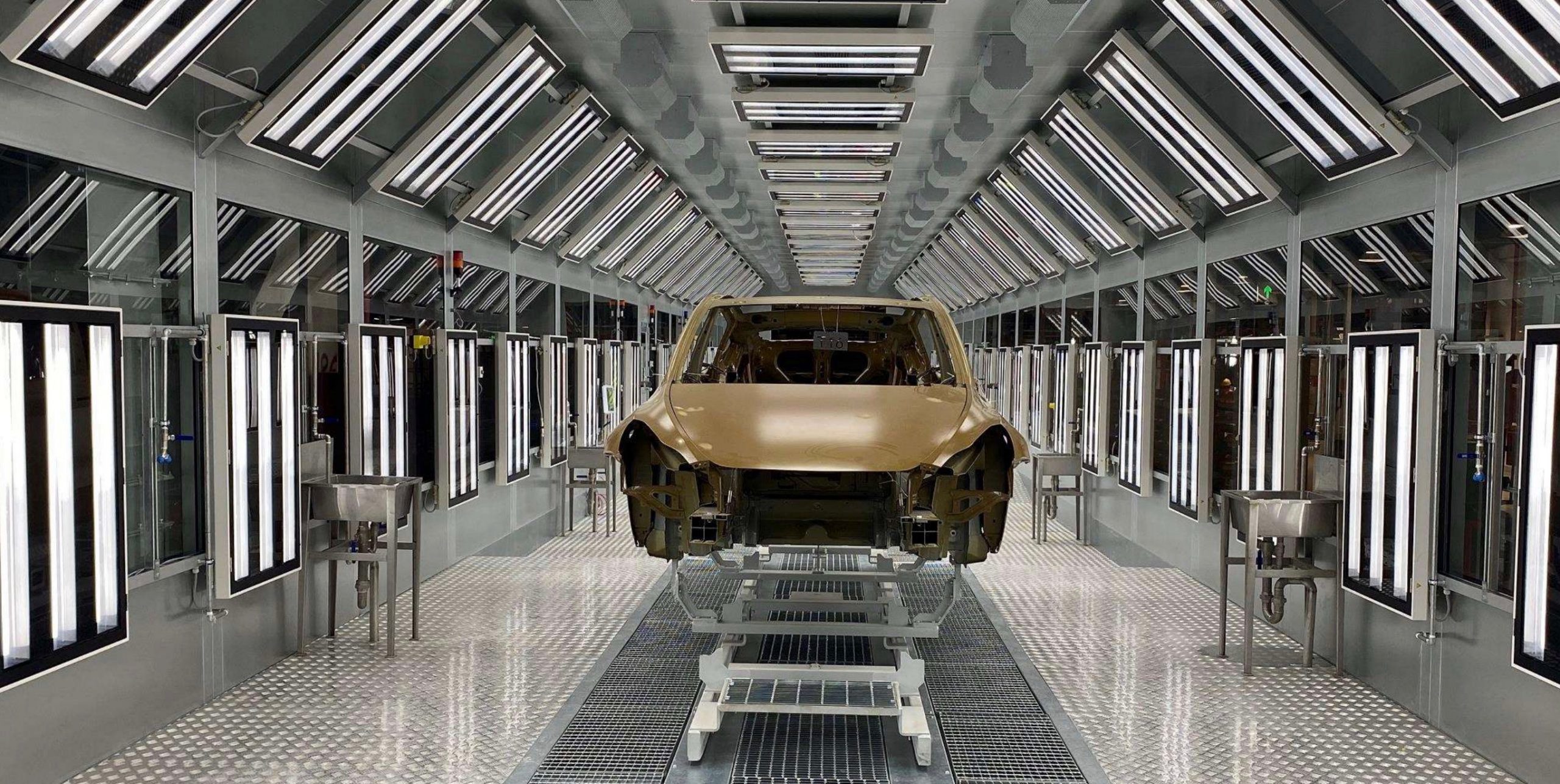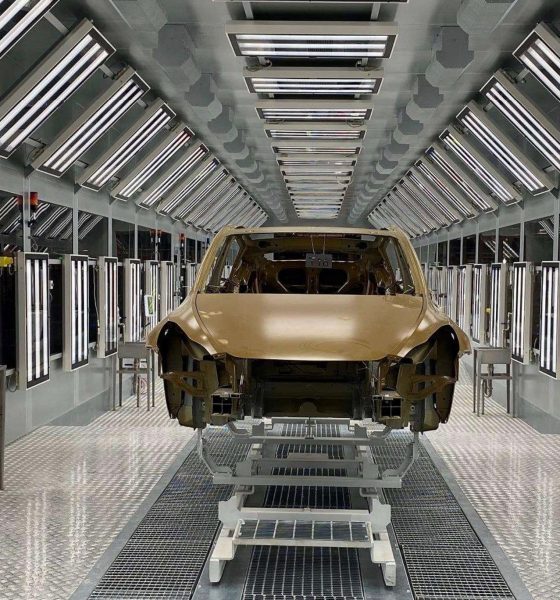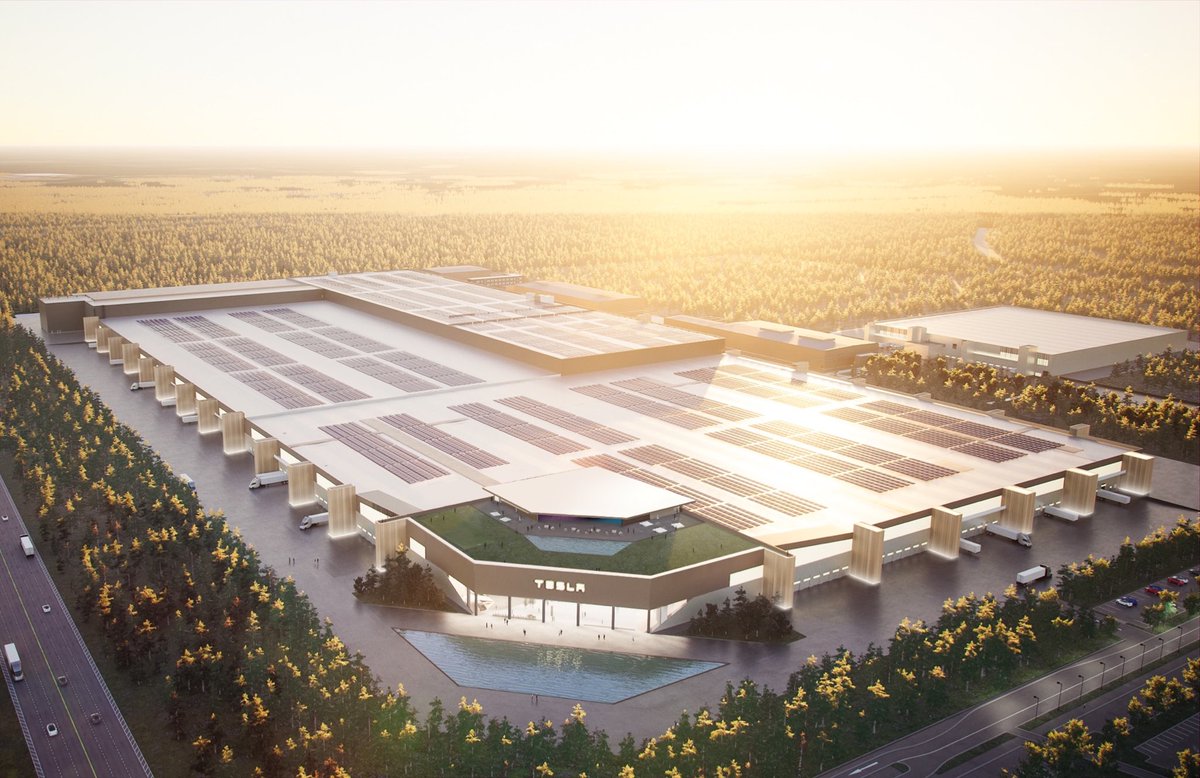

News
Tesla’s next-gen Model Y from Giga Berlin aims to redefine ‘German engineering’
Tesla’s next-generation Model Y from Giga Berlin in Germany may redefine “German engineering.” A Tweet from CEO Elon Musk shows the company aims to improve build quality down to the micron, a unit of measurement that is equivalent to one-thousandth of a millimeter.
“German engineering” is a phrase that has been around for decades and commonly refers to the precision and accuracy that German products are known for. In the automotive industry’s history, German vehicles have highly been regarded as the most luxurious, highest quality cars that money can buy. In the early years of industry and engineering, Germany had the best machines and the most advanced processes for building basically anything, but cars were the specialty. Strict standards and an attitude that aimed toward perfection made German vehicles the cream of the crop in the automotive industry.
Tesla Gigafactory Berlin render (Credit: Tesla)
This theory still holds true in today’s industry in many ways. While other companies and other regions have highly effective processes for vehicle manufacturing, Germany still has a certain mystique about it. With brands like Mercedes-Benz, Audi, and BMW, three of the most luxurious brands in the automotive market today, German engineering still holds a high standard.
However, Tesla has plans to reinvent the wheel when speaking about the term “German engineering.” In the last 18-or-so months since Elon Musk announced that Tesla’s first European Gigafactory would be in Germany, many developments have hinted toward Giga Berlin being the most advanced and most sophisticated factory that Tesla has in its arsenal. From a new, world-class paint facility to some of the most accurate automated machinery on the planet, Tesla is pulling out all the stops to keep up with Germany’s best brands.
In a Tweet earlier today, Musk said that Tesla is aiming for “extreme precision” with the next-gen Model Y. The company will aim for microns of accuracy, not millimeters, as Tesla aims to continue refining its manufacturing processes to make some of the highest-quality vehicles on Earth.
Aiming for extreme precision with next gen Model Y – microns, not millimeters
— Elon Musk (@elonmusk) May 18, 2021
In the past, Tesla has been criticized for poor build quality with some of its vehicles. Some owners have highlighted panel gaps or paint quality issues with their vehicles, which has led to an overwhelming misconception that Tesla produces lackluster vehicles. The truth is that all vehicle manufacturers have issues with build quality from time to time. Things as simple as an increased production rate can affect the quality of a vehicle. Some, however, like automotive veteran Sandy Munro, have stated that Tesla’s build quality has improved significantly over the years. Munro went from highly critical of the Model 3 during a teardown several years ago to overwhelmingly impressed with the new builds of the car.
“This car has improved significantly,” Munro said. “The paint is great; it’s very impressive.”
The accuracy that Tesla is aiming for with the next-gen all-electric Model Y crossover is extremely precise. A micron is one-thousandth of a millimeter, so it’s a unit that is not necessarily visible to the human eye. If Tesla can refine its manufacturing lines in Berlin to reach this level, the definition of German engineering may once again be reconfigured to include Tesla’s near-perfect build quality.
What do you think? Let us know in the comments below, or feel free to reach out to me directly at @KlenderJoey on Twitter or through email at joey@teslarati.com.

News
Tesla FSD fleet is nearing 7 billion total miles, including 2.5 billion city miles
As can be seen on Tesla’s official FSD webpage, vehicles equipped with the system have now navigated over 6.99 billion miles.

Tesla’s Full Self-Driving (Supervised) fleet is closing in on almost 7 billion total miles driven, as per data posted by the company on its official FSD webpage.
These figures hint at the massive scale of data fueling Tesla’s rapid FSD improvements, which have been quite notable as of late.
FSD mileage milestones
As can be seen on Tesla’s official FSD webpage, vehicles equipped with the system have now navigated over 6.99 billion miles. Tesla owner and avid FSD tester Whole Mars Catalog also shared a screenshot indicating that from the nearly 7 billion miles traveled by the FSD fleet, more than 2.5 billion miles were driven inside cities.
City miles are particularly valuable for complex urban scenarios like unprotected turns, pedestrian interactions, and traffic lights. This is also the difference-maker for FSD, as only complex solutions, such as Waymo’s self-driving taxis, operate similarly on inner-city streets. And even then, incidents such as the San Francisco blackouts have proven challenging for sensor-rich vehicles like Waymos.
Tesla’s data edge
Tesla has a number of advantages in the autonomous vehicle sector, one of which is the size of its fleet and the number of vehicles training FSD on real-world roads. Tesla’s nearly 7 billion FSD miles then allow the company to roll out updates that make its vehicles behave like they are being driven by experienced drivers, even if they are operating on their own.
So notable are Tesla’s improvements to FSD that NVIDIA Director of Robotics Jim Fan, after experiencing FSD v14, noted that the system is the first AI that passes what he described as a “Physical Turing Test.”
“Despite knowing exactly how robot learning works, I still find it magical watching the steering wheel turn by itself. First it feels surreal, next it becomes routine. Then, like the smartphone, taking it away actively hurts. This is how humanity gets rewired and glued to god-like technologies,” Fan wrote in a post on X.
News
Tesla starts showing how FSD will change lives in Europe
Local officials tested the system on narrow country roads and were impressed by FSD’s smooth, human-like driving, with some calling the service a game-changer for everyday life in areas that are far from urban centers.

Tesla has launched Europe’s first public shuttle service using Full Self-Driving (Supervised) in the rural Eifelkreis Bitburg-Prüm region of Germany, demonstrating how the technology can restore independence and mobility for people who struggle with limited transport options.
Local officials tested the system on narrow country roads and were impressed by FSD’s smooth, human-like driving, with some calling the service a game-changer for everyday life in areas that are far from urban centers.
Officials see real impact on rural residents
Arzfeld Mayor Johannes Kuhl and District Administrator Andreas Kruppert personally tested the Tesla shuttle service. This allowed them to see just how well FSD navigated winding lanes and rural roads confidently. Kruppert said, “Autonomous driving sounds like science fiction to many, but we simply see here that it works totally well in rural regions too.” Kuhl, for his part, also noted that FSD “feels like a very experienced driver.”
The pilot complements the area’s “Citizen Bus” program, which provides on-demand rides for elderly residents who can no longer drive themselves. Tesla Europe shared a video of a demonstration of the service, highlighting how FSD gives people their freedom back, even in places where public transport is not as prevalent.
What the Ministry for Economic Affairs and Transport says
Rhineland-Palatinate’s Minister Daniela Schmitt supported the project, praising the collaboration that made this “first of its kind in Europe” possible. As per the ministry, the rural rollout for the service shows FSD’s potential beyond major cities, and it delivers tangible benefits like grocery runs, doctor visits, and social connections for isolated residents.
“Reliable and flexible mobility is especially vital in rural areas. With the launch of a shuttle service using self-driving vehicles (FSD supervised) by Tesla in the Eifelkreis Bitburg-Prüm, an innovative pilot project is now getting underway that complements local community bus services. It is the first project of its kind in Europe.
“The result is a real gain for rural mobility: greater accessibility, more flexibility and tangible benefits for everyday life. A strong signal for innovation, cooperation and future-oriented mobility beyond urban centers,” the ministry wrote in a LinkedIn post.
News
Tesla China quietly posts Robotaxi-related job listing
Tesla China is currently seeking a Low Voltage Electrical Engineer to work on circuit board design for the company’s autonomous vehicles.

Tesla has posted a new job listing in Shanghai explicitly tied to its Robotaxi program, fueling speculation that the company is preparing to launch its dedicated autonomous ride-hailing service in China.
As noted in the listing, Tesla China is currently seeking a Low Voltage Electrical Engineer to work on circuit board design for the company’s autonomous vehicles.
Robotaxi-specific role
The listing, which was shared on social media platform X by industry watcher @tslaming, suggested that Tesla China is looking to fill the role urgently. The job listing itself specifically mentions that the person hired for the role will be working on the Low Voltage Hardware team, which would design the circuit boards that would serve as the nervous system of the Robotaxi.
Key tasks for the role, as indicated in the job listing, include collaboration with PCB layout, firmware, mechanical, program management, and validation teams, among other responsibilities. The role is based in Shanghai.
China Robotaxi launch
China represents a massive potential market for robotaxis, with its dense urban centers and supportive policies in select cities. Tesla has limited permission to roll out FSD in the country, though despite this, its vehicles have been hailed as among the best in the market when it comes to autonomous features. So far, at least, it appears that China supports Tesla’s FSD and Robotaxi rollout.
This was hinted at in November, when Tesla brought the Cybercab to the 8th China International Import Expo (CIIE) in Shanghai, marking the first time that the autonomous two-seater was brought to the Asia-Pacific region. The vehicle, despite not having a release date in China, received a significant amount of interest among the event’s attendees.








